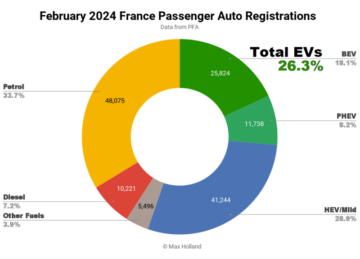Sign up for daily news updates from CleanTechnica on email. Or follow us on Google News!
Here’s a story about how a small change in technology can help solve a large problem for utility companies. Heimdall Power of Norway has developed a sensor it calls a Neuron, but which is known in the industry as a “magic ball.” In essence, what a Neuron does is wrap around a high voltage transmission line and read its temperature. Then it shares those readings in realtime with the operator of the transmission line.
Why is that important? Currently (no pun intended), at many times of the day there is more electricity available than can be transmitted by existing long distance power lines. If you have 1000 gallons of precious liquid that needs to get from where it is stored to where it is needed, but only a one-inch pipeline, that’s a problem. You could build a new two-inch pipeline, but that is super expensive (new high voltage transmission lines cost billions of dollars and take a decade or more to complete). What if you could make that existing pipeline carry up to 40% more liquid for a minimal investment? Is that something you would be interested in? Oh, you betcha.
What Is A Magic Ball?
The “magic ball” developed by Heimdall is about the size of a bowling ball. It weighs eight pounds and can be fastened to live power lines using a drone. The sensor operates using electricity it draws from the line to measure its temperature.
Transmission lines get hotter as the amount of power they are transmitting increases. By knowing the precise temperature, the grid operator knows how close the line is to maxing out on its capacity. “Think about the temperature on the line as being the speed limit,” Jørgen Festervoll, CEO of Heimdall, told Inside Climate News. “Without the software and sensor, like the ones Heimdall Power provides, you’re driving without a speedometer.”
In the absence of the temperature information the Heimdall “magic ball” provides, power companies set limits on the flow of power on a seasonal basis, rather than in response to real time conditions. That’s like deciding what speed you drive today based on the speed you drove a year ago, and can lead to a lot of unused capacity. By knowing exactly how much power a line can handle, an operator can increase the flow of power for hours or even days to get closer to the limit than otherwise would happen.
The technology has grown in popularity in Europe in recent years while remaining on the fringes of the US market. Great River Energy, a power provider to rural electric cooperative utilities in Minnesota, announced this week it will install 52 Heimdall “magic ball” sensors — which cost about $30,000 each — on its lines across the state. The decision comes following a positive experience with a pilot project in which four of the sensors helped to increase the amount of power that could be delivered on a line by up to 42.8%.
That means a transmission line that normally carries 1 MW of electricity could now carry 1.4 MW — a huge improvement at a time when transmission capacity in many parts of the US is at a premium and the lack of available capacity is a major choke point hindering the speed of development of renewable energy. If this technology is adopted, the big winners would include wind and solar power plants, especially those in remote areas, which could reduce how often they need to shut off because of a lack of line capacity.
Heimdall, a hardware and software company, says Great River’s order is the largest deployment of this kind of sensor technology to date in the United States. Previously, the largest order was 42 similar sensors supplied by LineVision last year to AES for its transmission lines in Indiana and Ohio. Heimdall is one of a growing number of companies, almost all of them less than a decade old, that work on what the power industry calls “grid enhancing technologies.” LineVision, based in Boston, is one and Ampacimon of Belgium is another. Heimdall, founded in 2016, has about 50 employees and customers in 17 countries, mostly in Europe.
The Magic Ball & PJM
RMI, the research and advocacy group, has written about the promise of grid enhancing technologies (GET) and lamented that US utilities have been slow to use these tools. In a report published last month that focused on how new technologies similar to the “magic ball” devices from Heimdall could help improve grid performance for PJM Interconnection, the country’s largest grid region, RMI said,
“GETs are hardware and software solutions that are deployed within the existing transmission system, helping increase the capacity, flexibility, and efficiency of the current grid. These transmission tools — dynamic line ratings (DLRs), advanced power flow controls (PFCs), and topology optimization (TO) — are becoming more widely studied and deployed in the United States as well as internationally, However, they are not yet routinely considered in planning paradigms such as grid operators’ interconnection studies. Because they are cheaper and quicker to install than other types of transmission upgrades, such as reconductoring or rebuilding lines, GETs have tremendous potential to expedite the integration of new resources onto the grid.”
RMI says it costs vastly more to build new transmission lines than it does to implement grid enhancing technologies. It adds that it is important to understand that GETs by themselves don’t mean that companies won’t need to build new lines to meet anticipated demand.
If these new sensor technologies are popular in Europe, why are they not so popular in the US? Chaz Teplin of RMI said companies sometimes are wary of the complexity of having one more thing to monitor and an additional set of knobs in a control room. But he thinks the leading factor is that the utility business model places a premium on building and maintaining large assets. Most utilities make money through a regulated process in which they can charge customers to cover costs plus a guaranteed profit.
“Utilities often don’t have much of a financial incentive to do these really low cost investments,” Teplin said. “So something that provides a lot of value, if it’s not very capital intensive, doesn’t actually help them with their bottom line.” He said it is the job of regulators and regional grid managers to fix what is an unhelpful “misalignment of financial incentives.”
Chip in a few dollars a month to help support independent cleantech coverage that helps to accelerate the cleantech revolution!
The RMI report on GETs showed that the gains utility companies reported after using such devices varied significantly based on the time of day and the month. Gains during overnight hours in November were in the single digit range while those during daylight hours in April were more than 30%. Sharpeyed readers will notice that daytime is when solar farms typically produce electricity and the need to maximize grid capacity is at its highest. Demand in the middle of the night is always low, so there is little call to transmit large amounts of electricity then.
Air temperatures and wind levels play a major role in determining how much power can be transmitted at any particular moment. A low air temperature and a high wind help cool transmission lines, which allows them to carry more electricity. But those environmental factors fluctuate over time, which is why simply adding GETs does not result in higher transmission levels all the time. What the “magic ball” from Heimdall and similar devices do is give grid operators the information they need to maximize how much electricity can be distributed over existing transmission lines at any particular time.
Inside Climate News suggests wind and solar plant operators would benefit the most from technologies like the Heimdall “magic ball” because they have the effect of opening new travel lanes on highways that otherwise would be congested. These plants would have priority to use the newfound capacity because they are usually the least expensive resources. An increase in the availability of wind and solar would lead to less demand for more expensive power sources, including coal.
The Takeaway
The big beneficiaries of grid enhancement technologies would be utility ratepayers. If grid operators can facilitate the delivery of more wind and solar without building new lines, the result is likely going to reduce electricity costs. “It’s going to save customers money,” said Chaz Teplin of RMI.
The fact that these devices are not being widely used illustrates a fallacy in how utilities are regulated. In most cases, they make more money by building more stuff. Everything they build has a fixed return on investment set by regulators. If they want to earn more money, they need to build new generating stations, transmission lines, and so forth. Saving customers money hardly figures into the thinking of large investor-owned utilities at all. That’s a huge flaw in the regulatory process and there is very little incentive to change it.
Have a tip for CleanTechnica? Want to advertise? Want to suggest a guest for our CleanTech Talk podcast? Contact us here.
Latest CleanTechnica TV Video
[embedded content]
Advertisement
CleanTechnica uses affiliate links. See our policy here.
- SEO Powered Content & PR Distribution. Get Amplified Today.
- PlatoData.Network Vertical Generative Ai. Empower Yourself. Access Here.
- PlatoAiStream. Web3 Intelligence. Knowledge Amplified. Access Here.
- PlatoESG. Carbon, CleanTech, Energy, Environment, Solar, Waste Management. Access Here.
- PlatoHealth. Biotech and Clinical Trials Intelligence. Access Here.
- Source: https://cleantechnica.com/2024/03/22/heimdall-magic-ball-increases-transmission-line-capacity/
- :has
- :is
- :not
- :where
- $UP
- 000
- 1
- 17
- 2016
- 4
- 400
- 42
- 50
- 52
- a
- About
- absence
- accelerate
- across
- actually
- adding
- Additional
- Adds
- adopted
- advanced
- Advertise
- advocacy
- AES
- Affiliate
- After
- ago
- AIR
- All
- allows
- almost
- always
- amount
- amounts
- an
- and
- announced
- Another
- Anticipated
- any
- April
- ARE
- areas
- around
- AS
- Assets
- At
- availability
- available
- ball
- based
- basis
- BE
- because
- becoming
- been
- being
- Belgium
- beneficiaries
- benefit
- Big
- billions
- boston
- Bottom
- build
- Building
- business
- business model
- but
- by
- call
- Calls
- CAN
- Capacity
- capital
- carry
- cases
- ceo
- change
- charge
- cheaper
- cleantech
- Cleantech Talk
- Climate
- Close
- closer
- Coal
- comes
- Companies
- company
- complete
- complexity
- conditions
- considered
- content
- control
- controls
- Cool
- cooperative
- Cost
- Costs
- could
- countries
- country’s
- cover
- Current
- Currently
- Customers
- Date
- day
- daylight
- Days
- decade
- Deciding
- decision
- delivered
- delivery
- Demand
- deployed
- deployment
- determining
- developed
- Development
- Devices
- Digit
- distance
- distributed
- do
- does
- Doesn’t
- dollars
- Dont
- draws
- drive
- driving
- drone
- during
- dynamic
- each
- earn
- effect
- efficiency
- eight
- Electric
- electricity
- embedded
- employees
- energy
- enhancement
- enhancing
- environmental
- especially
- essence
- Ether (ETH)
- Europe
- Even
- everything
- exactly
- existing
- expedite
- expensive
- experience
- facilitate
- fact
- factor
- factors
- Farms
- few
- Figures
- financial
- Fix
- fixed
- flaw
- Flexibility
- flow
- fluctuate
- focused
- following
- For
- forth
- Founded
- four
- from
- Gains
- generating
- get
- gets
- Give
- going
- great
- Grid
- Group
- Growing
- grown
- guaranteed
- Guest
- handle
- happen
- hardly
- Hardware
- Have
- having
- he
- help
- helped
- helping
- helps
- High
- higher
- highest
- highways
- HOURS
- How
- However
- HTTPS
- huge
- if
- illustrates
- implement
- important
- improve
- improvement
- in
- Incentive
- Incentives
- include
- Including
- Increase
- Increases
- independent
- Indiana
- industry
- information
- install
- integration
- intended
- intensive
- interconnection
- interested
- internationally
- into
- investment
- Investments
- IT
- ITS
- Job
- Kind
- Knowing
- known
- knows
- Lack
- large
- largest
- Last
- Last Year
- lead
- leading
- least
- less
- levels
- like
- likely
- LIMIT
- limits
- Line
- lines
- links
- Liquid
- little
- live
- Long
- Lot
- Low
- magic
- maintaining
- major
- make
- make money
- Managers
- many
- Market
- max-width
- Maximize
- mean
- means
- measure
- Meet
- Middle
- minimal
- minnesota
- model
- moment
- money
- Monitor
- Month
- more
- most
- mostly
- much
- Need
- needed
- needs
- New
- New technologies
- news
- night
- no
- normally
- Norway
- Notice..
- November
- now
- number
- of
- off
- often
- oh
- Ohio
- Old
- on
- ONE
- ones
- only
- onto
- opening
- operates
- operator
- operators
- optimization
- or
- order
- Other
- otherwise
- our
- out
- over
- overnight
- paradigms
- particular
- parts
- performance
- pilot
- pilot project
- pipeline
- Places
- planning
- plant
- plants
- plato
- Plato Data Intelligence
- PlatoData
- Play
- player
- plus
- podcast
- policy
- Popular
- popularity
- positive
- potential
- pounds
- power
- power plants
- Precious
- precise
- Premium
- previously
- priority
- Problem
- process
- produce
- Profit
- project
- promise
- provider
- provides
- published
- quicker
- range
- rather
- ratings
- Read
- readers
- real
- real-time
- really
- realtime
- rebuilding
- recent
- reduce
- region
- regional
- regulated
- Regulators
- regulatory
- remaining
- remote
- Renewable
- renewable energy
- report
- Reported
- research
- Resources
- response
- result
- return
- River
- Role
- Room
- routinely
- Rural
- Said
- Save
- saving
- says
- seasonal
- see
- sensors
- set
- Shares
- showed
- shut
- significantly
- similar
- simply
- single
- Size
- slow
- So
- Software
- solar
- Solar Power
- Solutions
- SOLVE
- something
- sometimes
- Sources
- speed
- State
- States
- Stations
- stored
- Story
- studied
- studies
- stuff
- such
- suggest
- Suggests
- Super
- supplied
- support
- system
- Take
- Talk
- Technologies
- Technology
- than
- that
- The
- the information
- The State
- their
- Them
- themselves
- then
- There.
- These
- they
- thing
- Thinking
- Thinks
- this
- this week
- those
- Through
- time
- times
- tip
- to
- today
- told
- tools
- transmission
- transmit
- travel
- tremendous
- tv
- types
- typically
- understand
- United
- United States
- unused
- Updates
- upgrades
- us
- use
- used
- uses
- using
- usually
- utilities
- utility
- value
- varied
- very
- Video
- Voltage
- want
- was
- week
- weighs
- WELL
- were
- What
- What is
- when
- which
- while
- why
- widely
- will
- wind
- winners
- with
- within
- without
- Work
- would
- wrap
- written
- year
- years
- yet
- you
- youtube
- zephyrnet






